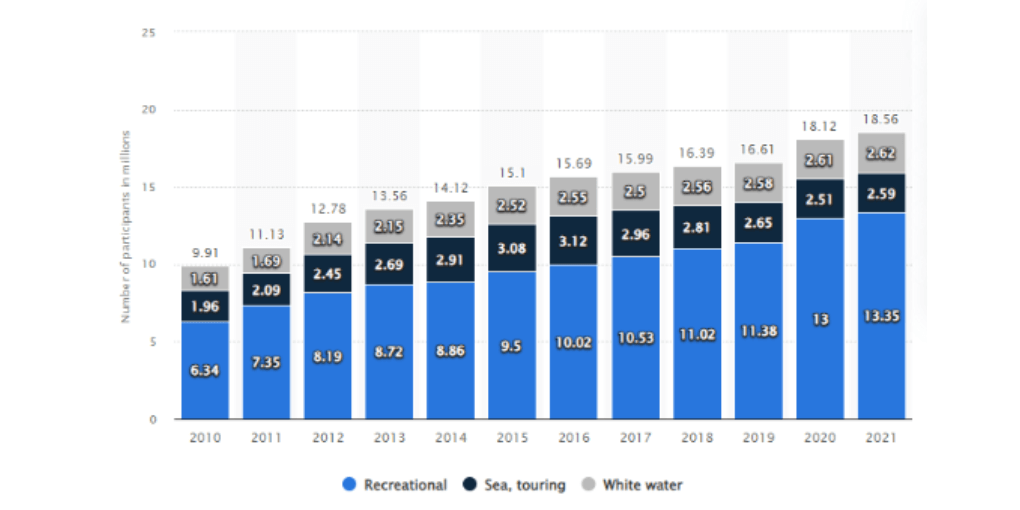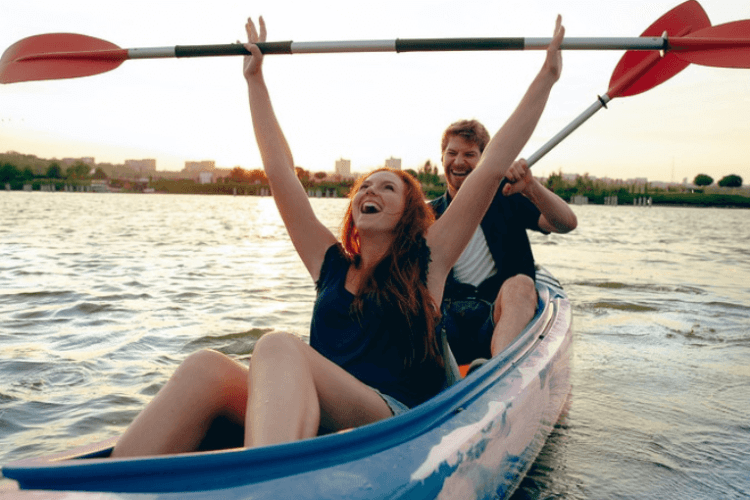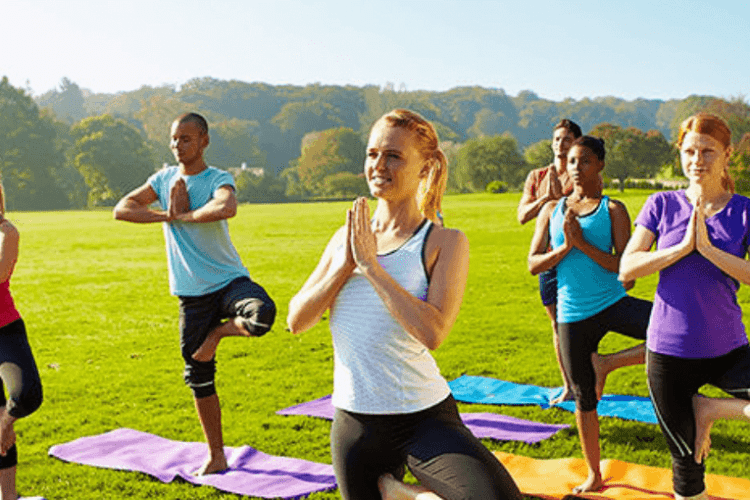Different Water Conditions: Tips for River, Lake, and Ocean
Do you know, how kayaking is popular to all? Well, I can show you some statistics…

According to the research of Statista, kayaking is becoming a part of everyone’s life.
With my professional experience, I can say that kayaking is not an easy job for all types of water. That’s why I’m telling you here about different water conditions that everyone should know.
Here,
- I can share about the water conditions
- And safety tips for enjoying the water
Let’s jump on the articles and enjoy the opinion.
River Kayaking Tips
An interesting news is that “The fastest recorded kayak speed is 17.57 mph, set by Spanish racer Antonio de la Rosa in 2019. ”
This type of kayaking is the most common type of kayaking, accounting for more than 71% of participants in 2021.
For river kayaking, you need to understand currents, read the water for obstacles, wear a helmet and PFD, and practice rolling techniques. Stay alert to changing river conditions and hazards.
Developing these essential skills and safety measures will help you navigate rivers safely. Then you can enjoy the thrill of whitewater kayaking properly.
A. Understanding River Currents
- There are different types of river currents, such as eddies, rapids, and whitewater
- You need to understand how currents flow and affect your kayak
- Reading the Water
- Importance of observing and interpreting visual cues on the river surface
- How to spot potential hazards like rocks, logs, and fast-moving water
- Strategies for planning your route based on reading the water effectively
- Safety Equipment Essentials
- Wearing a helmet is crucial in river kayaking
- Wearing a proper PFD and other safety gear
Lake Kayaking Tips
Statistics show that Kayaking involvement in the United States increased by 87.3% between 2010 and 2021, with an estimated 11.4 million active kayakers in 2021.
Lake kayaking offers serene waters but presents challenges like wind and boat traffic.
Choose a stable kayak and wear a PFD. Check weather forecasts and avoid kayaking in strong winds.
Stay visible with bright clothing and lights in low visibility. Be mindful of boat traffic, keeping close to shore when possible. Always bring essentials like water, sunscreen, and a communication device.
- Checking Weather Conditions
- Checking the weather forecast before heading out on the lake
- How wind, waves, and other weather factors can impact lake kayaking
- You should always prepare for changing weather conditions while on the lake
- Visibility Tips
- Try to make yourself visible to other boaters on the lake
- Importance of using bright colors or flags on your kayak for visibility
- Packing Essentials
- Remember to pack enough water, sunscreen, and other essentials for a day on the lake
- You also carry light for a comfortable kayaking experience
- You should keep additional safety items to include in your kit for lake kayaking
- Personal Safety Gear
- Wearing a proper PFD while kayaking on the lake
- Protect your head with a helmet where rocks and rapids pose risks.
- Carry a whistle to signal for help in emergencies or to alert others to your presence.
Ocean Kayaking Tips
Ocean kayaking demands respect for its dynamic environment. Use a sea-worthy kayak with sealed hatches. Check marine forecasts and tides.
Avoid strong currents and offshore winds. Wear a PFD and carry essential safety gear, including a VHF radio or personal locator beacon.
Stay vigilant for changing conditions and marine traffic. Paddle with a buddy and inform others of your plans.
- Tides and Currents Awareness
- Learn how tides impact water levels and currents in the ocean.
- Be aware of dangerous rip currents that can pull you out to sea.
- Plan your routes to paddle with or against currents for a smoother kayaking experience.
- Navigation Tools
- Carry a GPS device to track your location, mark waypoints, and navigate unfamiliar waters.
- Use a compass to orient yourself and maintain direction while kayaking.
- Use natural landmarks, such as mountain peaks or distinctive trees, for navigation reference.
- Clothing Recommendations
- Opt for quick-drying materials like nylon or polyester to stay comfortable on the water.
- Wear moisture-wicking base layers, insulating mid-layers, and a waterproof outer layer for versatility in changing weather.
- Wearing a wide-brimmed hat, sunglasses, and sunscreen to protect against sun exposure while kayaking.
- Paddling With a Buddy
- Always paddle with a buddy or a group for increased safety and support on the water.
- Share essential gear like safety equipment, food, and water to ensure both paddlers are prepared.
- Paddling with a buddy enhances the fun and enjoyment of kayaking while fostering a sense of camaraderie and teamwork.
General Kayaking Safety Tips
- Wear a Personal Flotation Device (PFD): Always wear a properly fitting PFD to stay safe on the water.
- Learn Basic Paddling Techniques: Take a kayaking course to learn essential paddling strokes and maneuvers.
- Check Weather Conditions: Keep an eye on weather forecasts and avoid kayaking in severe weather conditions.
- Stay Hydrated: Bring plenty of water to stay hydrated during your paddling adventure.
- Inform Someone of Your Plans: Let a friend or family member know your paddling plans and expected return time.
- Follow Local Regulations: Obey waterway rules and regulations, including any restrictions on where you can kayak.
- Practice Self-Rescue Techniques: Learn how to self-rescue in case of a capsize or emergency situation.
- Respect Marine Life: Avoid disturbing wildlife and marine ecosystems while kayaking.
- Carry Safety Equipment: Pack essential safety gear such as a whistle, flashlight, and first aid kit.
- Trust Your Instincts: If conditions feel unsafe, trust your instincts and err on the side of caution. Your safety is the top priority.
Conclusion
Whether you’re kayaking on a river, lake, or ocean, it’s important to remember a few key tips to stay safe and have great time!
Always wear your life jacket, listen to grown-ups about where it’s safe to paddle, and be aware of the water around you.
Rivers can have currents, lakes can be calm or windy, and oceans have tides that change. By learning about these differences and being prepared, you can enjoy kayaking in different water conditions while having fun and staying safe.
So, remember to paddle smart, stay safe, and make happy memories on the water, no matter where your kayak adventure takes you!
FAQs
Wearing a life jacket keeps you safe in case you fall into the water. It helps you float and stay afloat until someone can help you.
Grown-ups know the best places to kayak where it's safe and fun. They can tell you about any dangers in the water that you should avoid.
Rivers can have fast currents, lakes may be calm or windy, and oceans have changing tides. Understanding these differences helps you prepare for your kayaking adventure.
Being aware of water conditions helps you make smart decisions while paddling. It allows you to have fun while staying safe and enjoying your time on the water.


